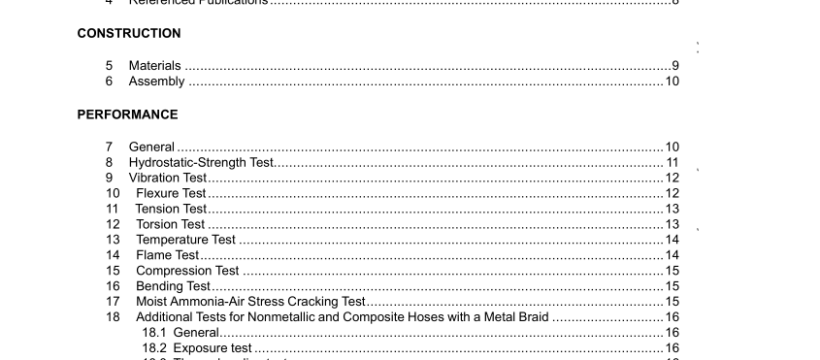UL 30-2019 pdf download.Metal Safety Cans.
5 General 5.1 The minimum width or diameter of the base of a can shall not be less than 85 percent of the height of the body. 5.2 An opening shall be above the highest intended liquid level. The opening shall not be provided with a removable plug or with a stuffing box leading directly into the can. 5.3 Each opening shall have an automatic valve that remains closed with the can placed in any position. The valve shall be capable of being opened manually. 5.4 A can having a nominal capacity of 1.1 quarts (1 L) or less shall not have more than one opening. The opening shall be adapted for pouring and filling. 5.5 A can having a nominal capacity of more than 1.1 quarts (1 L) shall not have more than two openings. 5.6 Separate pouring and filling valves shall operate independently of each other. 5.7 A spout used for filling, or a separate fill opening, shall be constructed so that the use of a funnel or other article during a filling operation will not interfere with free venting of the can. 5.8 A pouring spout shall be constructed to reduce the likelihood of spillage during pouring. 5.9 A Type II can shall incorporate a vent valve to permit the free discharge of liquid during a pouring operation. The vent valve shall open and close automatically and simultaneously with the opening and closing of the pouring valve. 5.10 An operating part of a can shall be constructed to reduce the likelihood of unintended opening of a valve. 5.11 Internal pressure in excess of 5 psig (34 kPa) shall be relieved by overcoming the spring pressure on the pouring- or filling-valve closure, or through an independent pressure-relief device.
7 Seams and Joints 7.1 Seams and joints in the top, body, and bottom of a can shall be welded, brazed, or lock-seamed. A lock-seamed joint shall be sweated with solder. Exception: A container employing unsoldered lock-seams that complies with the Drop Test, Section 18, need not have the lockseams sweated with solder. 7.2 A formed, circumferential top or bottom seam shall have strength equivalent to that of a double standing seam. A formed, vertical seam shall have strength equivalent to that of an offset hook seam. The metal overlap of a formed seam shall not be less than 1/8 inch (3.2 mm) wide. 8 Pouring Spouts and Fill Fittings 8.1 A pouring spout or fill fitting shall be of corrosion-resistant metal or of ferrous metal that is provided with a corrosion-resistant coating that complies with the requirements in Corrosion-Resistant Coatings, Section 15. 8.2 A cast pouring spout or fill fitting shall not be less than 1/8 inch (3.2 mm) thick. The wall thickness of tubing or other drawn material shall not be less than 0.05 inch (1.3 mm). 8.3 The internal diameter of a fill fitting shall not be less than the appropriate value specified in Table 8.1.
9 Pouring Nozzles – Type II Cans 9.1 A flexible or rigid nozzle of a Type II can shall be of corrosion-resistant metal, or ferrous metal provided with a corrosion-resistant coating that complies with the requirements in Corrosion-Resistant Coatings, Section 15. 9.2 The metal used in a flexible nozzle shall not be less than 0.015 inch (0.38 mm) thick. A rigid nozzle shall not be less than 0.035 inch (0.89 mm) thick. 9.3 The discharge end of a flexible nozzle shall be provided with a ferrule of corrosion-resistant metal. The ferrule shall be secured in place and shall enclose all sharp or projecting edges. 9.3.1 Deleted 9.3.2 Deleted 9.4 The valve or inlet end of a flexible nozzle shall be supported or reinforced by a closely wound external helical spring. The spring shall not be less than 3 inches (76.2 mm) long and shall be secured in place. 9.5 A nozzle shall be secured to a fitting constructed for attachment to the pouring spout. This fitting, in turn, shall be attached to the pouring spout by a method that provides a permanent connection that is free from leakage. Also, see Flexible Nozzle Test, Section 23. 9.6 A nozzle intended for use in automotive fueling applications for pouring directly into the fuel tank of a vehicle requiring unleaded gasoline shall have a maximum outside diameter of 0.86 inch (21.8 mm). When a safety can is equipped with a nozzle having an outside diameter not greater than 0.86 inch (21.8 mm), the safety can is not prohibited from being marked in accordance with paragraph 28.3.UL 30-2019 pdf download.
UL 30-2019 pdf download
